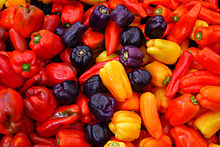| Capsicum annuum | |
|---|---|
 | |
| Capsicum annuum cultivars | |
| Scientific classification | |
| Kingdom: | Plantae |
| (unranked): | Angiosperms |
| (unranked): | Eudicots |
| (unranked): | Asterids |
| Order: | Solanales |
| Family: | Solanaceae |
| Genus: | Capsicum |
| Species: | C. annuum |
| Binomial name | |
| Capsicum annuum L. | |
| Varieties | |
| C. a. var. annuum Capsicum annuum L. var. grossum Capsicum annuum var. lycopersiciforme C. a. var. glabriusculum[1] | |
Contents
|
Characteristics
Although the genus name annuum means “annual” (from the Latin annus “year”, the plant is not an annual and in the absence of winter frosts can survive several seasons and grow into a large perennial shrub.[3] The single flowers are an off-white (sometimes purplish) color whilst the stem is densely branched and up to 60 centimetres (24 in) tall. When ripe, the fruit may be green, yellow or red. Whilst the species can tolerate most climates, C. annuum is especially productive in warm and dry climates.Uses
Culinary
The species is a source of popular sweet peppers and hot chilis with numerous varieties cultivated all around the world. In American English the plant is commonly known as a chili pepper or bell pepper.In British English, the sweet varieties are called red or green peppers[4] and the hot varieties chillies[5], whereas in Australian and Indian English the name capsicum is commonly used for bell peppers exclusively and chilli is often used to encompass the hotter varieties.
Sweet peppers are very often used as a bulking agent in cheap ready made meals/take-away food as they are cheap, have a strong flavour, and are colorful. The colorful aspect of peppers increases the visual appeal of the food, making it more appetizing. Foods containing peppers, especially chili peppers, often have a strong aftertaste this is due to the presence of capsinoids in peppers. Capsaicin, a chemical found in chili peppers, creates a burning sensation once ingested which can last for several hours after ingestion.
Medicinal
Hot peppers are used in medicine as well as food in Africa[6] and other countries.English botanist John Lindley described C. annuum on page 509 of his 1838 'Flora Medica' thus:
| “ | It is employed in medicine, in combination with Cinchona in intermittent and lethargic affections, and also in atonic gout, dyspepsia accompanied by flatulence, tympanitis, paralysis etc. Its most valuable application appears however to be in cynanche maligna (acute diptheria) and scarlatina maligna (malignent Scarlet fever, used either as a gargle or administered internally. | ” |
- Gunna (properties) – ruksh (dry), laghu (light) and tikshan (sharp)
- Rasa dhatu (taste) – katu (pungent)
- Virya (potency) – ushan (hot)
Ornamental
Gallery
- Dried Guajillo chile pod
 Unknown
Unknown










0 komentar:
Post a Comment